Selecting Microwave Digestion Technology for Measuring Heavy Metals in Cannabis Products
By Ryan Boyle and Eric Farrell
Microwave digestion is an excellent tool that provides complete dissolution for the accurate and precise testing of heavy metals in cannabis and its products using plasma spectrochemical techniques, such as inductively coupled plasma–optical emission spectrometry (ICP-OES) and inductively coupled plasma–mass spectrometry (ICP-MS). However, there are many different options of commercially available microwave digestion systems, each with their own strengths and weaknesses. The optimum choice will often depend on the workload and sample diversity of the cannabis testing laboratory carrying out the analysis.
This article describes the basic principles of the major types of microwave digestion technology and offers suggestions as to which might be the best approach based on sample matrix, digestion efficiency, sample throughput, productivity, and overall cost of analysis. The article is supplemented by real-world examples of how different microwave technologies are being utilized in cannabis testing laboratories for the digestion and measurement of heavy metals by ICP-MS.
With increased state regulations, cannabis growers are required to conduct trace metals testing to ensure a safe and high-quality product. This testing encompasses a wide variety of samples from growers and the processing industry including soils, fertilizers, plant material, edible products, concentrates, and topicals.
Obtaining analytical data required to ensure quality products starts with the crucial step of preparing the sample for analysis. Reducing handling steps, eliminating outside contamination, and minimizing reagent blank contribution are all necessary for good sample preparation.
It is well recognized that closed-vessel microwave digestion offers the best approach for getting your samples into solution for analysis by inductively coupled plasma–optical emission spectrometry (ICP-OES) or inductively coupled plasma–mass spectrometry (ICP-MS). However, there are basically two very different commercially available designs: rotor-based systems and single reaction chamber (SRC) technology (1).
So, how do you go about selecting the optimum technology for your samples? What types of mineral acids will be best suited for your elements of interest, and what temperature and pressure will be required for the digestion process of your sample matrices? It’s only when you have a good understanding of these issues, that you can begin to look more closely at the pros and cons of the different commercially-available microwave technology. So first, let’s take a closer look at the fundamental principles of both designs.
Principles of Microwave Digestion Technology
First it should be emphasized that sample digestion of organic matrices such as cannabis products should be carried out using reagents compatible with ICP-OES and ICP-MS instrumentation. For example, the chemical or physical properties and concentration of the mineral acids used and how they affect the sample introduction nebulization processes and the potential matrix-suppression effects in the plasma should be taken into consideration. It is therefore well-recognized that the most plasma spectrochemical-friendly reagents are typically strong oxidizing agents such as nitric acid (HNO3) and hydrogen peroxide (H2O2), which are extremely efficient, but tend to generate large amounts of carbon dioxide (CO2) and various oxides of nitrogen (NOx) when they react with the samples.
The microwave system and its components will therefore not only need to accommodate the high temperature required to digest all the different organic sample types, but also be able to handle the subsequent increase in pressure produced by the generation of large volumes of these gases. For some samples, the addition of small amounts of hydrochloric acid will also help to stabilize some elements particularly mercury (Hg) and the platinum group elements. However, it should be noted that if ICP-MS is being used as the analytical technique the 40Ar35Cl polyatomic species could potentially interfere with monoisotopic arsenic (As) at 75 atomic mass units (amu). This interference can be alleviated using a collision–reaction cell (CRC), but it is important to be aware of this potential problem so that the optimum instrumental conditions are used.
Rotor-Based Technology
With rotor-based technology, microwaves are directed onto vessels containing the sample and the digestion reagents, which are placed in a rotating carousel. The digestion process is accomplished by raising the pressure and temperature through microwave irradiation, as the carousel is rotating. This increase in temperature and pressure, together with the optimum reagent, increases both the speed of thermal decomposition of the sample and the solubility of metals in solution. Rotor-based systems work extremely well for similar matrices by batching all samples together that react in the same way. By carrying out the digestion process using the same microwave power, temperature, and pressure conditions, it will ensure similar digestion quality in all positions. To increase throughput, different sized carousels can be used depending on the sample workload.
However, when many different sample matrices have to be digested, productivity could be sacrificed, because each sample type has to be batched together, which unfortunately precludes different samples being digested together in the same sample run. Additionally, the strength of any rotor-based system is the ability to achieve high pressure and safely vent the excess pressure caused by the buildup of CO2 and NOx during the digestion process. There are basically three different approaches used to carry out this process (2). They are:
- Vent and reseal
- Burst disk
- Self-regulating
Let’s take a closer look at how they work.
Vent-and-Reseal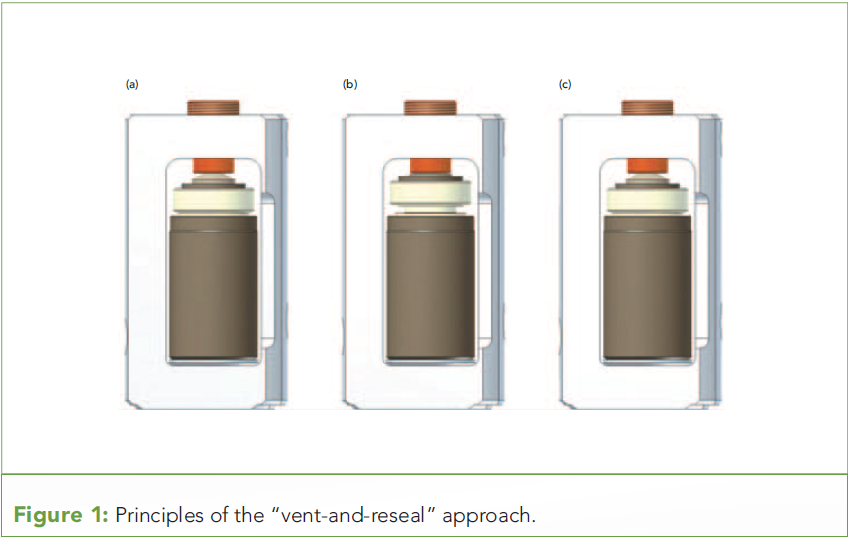
This patented technology (3) eliminates vessel failure in the case of an out of control exothermic reaction. Figure 1 shows “vent-and-reseal” in action: the vessel cap is held in place by a domeshaped spring (Figure 1a). In the case of over pressurization because of a highly exothermic reaction, the spring is flattened, allowing the cap to lift up slightly (Figure 1b), releasing excess pressure. Immediately, the excess pressure is released, the spring reseals the vessel (Figure 1c), and the digestion continues. There is no loss of sample and no clean up needed. The microwave program continues to completion and no rerun is required.
Burst Disk This method uses a simple burst disk in the cap that is designed to fail in an over-pressure situation, instantly releasing all pressure in the vessel. When this happens, instantaneous boiling occurs, the sample contents are lost, and the run has to be manually stopped. The result is that a significant cleanup of the cavity is required, with a strong possibility that corrosion of internal components will occur. This is exemplified in Figure 2, which compares the burst disk approach with vent-and-reseal: the red line shows the complete loss of pressure when a burst disk fails, and the whole run is stopped. Whereas, the blue line shows that with the ventand-reseal technology, excess pressure is gently released at the vessel’s pressure limit (f.i. 30 bar), and the digestion continues to completion, with no loss of sample.
This method uses a simple burst disk in the cap that is designed to fail in an over-pressure situation, instantly releasing all pressure in the vessel. When this happens, instantaneous boiling occurs, the sample contents are lost, and the run has to be manually stopped. The result is that a significant cleanup of the cavity is required, with a strong possibility that corrosion of internal components will occur. This is exemplified in Figure 2, which compares the burst disk approach with vent-and-reseal: the red line shows the complete loss of pressure when a burst disk fails, and the whole run is stopped. Whereas, the blue line shows that with the ventand-reseal technology, excess pressure is gently released at the vessel’s pressure limit (f.i. 30 bar), and the digestion continues to completion, with no loss of sample.
Self-Regulating Rotors
This third approach is typically used in high-throughput rotors, which were developed to address the needs of laboratories that process larger sample volumes on a routine basis. Self-regulating vessels are very easy to assemble and disassemble and rely on the PTFE sealing plug inside the cap deforming to release pressure. Their compact design results in more moderate temperature and pressure capabilities, but allows for a large number of vessels to fit onto the rotor. These characteristics make self-regulating rotors ideal for high workload laboratories with relatively straight forward applications such as clinical, environmental, and food. Most recently, the self-regulating approach has been applied to high pressure rotors designed specifically for more challenging sample types. Since self-regulating vessels are designed to vent, incomplete digestions may be observed given that the pressure loss does not allow the required temperatures necessary for complete digestion to be achieved.
Single Reaction Chamber Technology
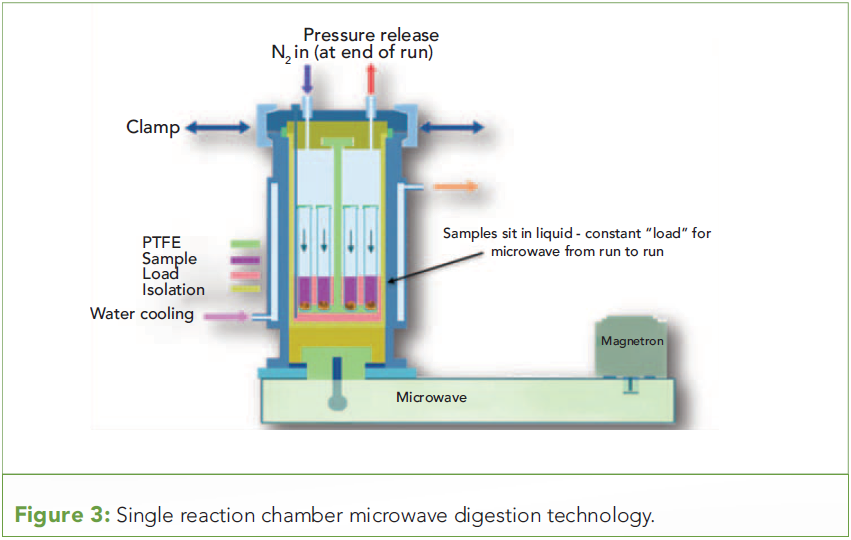 So let’s take a more detailed look at the principles of single reaction chamber (SRC) technology, and how it differs from the rotor-based system. Instead of a rotor with a discrete sample vessel, the samples are put into vials with loose-fitting caps, which are sitting in a rack that is lowered into a larger vessel containing a base load of acidified water. It’s this baseload that absorbs the microwave energy and transfers it to the vial. This design allows every vial to react independently within the base load and ensures that all samples achieve maximum temperature with pressures contained up to 200 bar. No batching of samples is necessary, and any combination of sample type and acid chemistry can be run simultaneously in the same chamber.
So let’s take a more detailed look at the principles of single reaction chamber (SRC) technology, and how it differs from the rotor-based system. Instead of a rotor with a discrete sample vessel, the samples are put into vials with loose-fitting caps, which are sitting in a rack that is lowered into a larger vessel containing a base load of acidified water. It’s this baseload that absorbs the microwave energy and transfers it to the vial. This design allows every vial to react independently within the base load and ensures that all samples achieve maximum temperature with pressures contained up to 200 bar. No batching of samples is necessary, and any combination of sample type and acid chemistry can be run simultaneously in the same chamber.
A schematic of the SRC is shown in Figure 3. As previously mentioned, loose-fitting caps are used to seal the vials. This is possible because they are pre-pressurized with 40 bar of nitrogen before the start of the microwave program, which acts as a gas cap and keeps all the vials independently closed. As the pressure builds, equilibrium is achieved both inside and outside the vial. As a result, a variety of vial types including disposable glass, quartz, and PTFE or any combination of these materials can be used (4).
Benefit of Nitrogen Pressurized Caps
 To exemplify that 40 bar of nitrogen is sufficient to seal the vials, an experiment was carried out where vials containing 110 ppm of mercury were placed right next to blank solutions in a 15-rack sample holder. In other words, every alternate sample vial in the rack contained either 110 ppm or 0 ppm mercury. It is well recognized that mercury is highly volatile, particularly when heated, and would contaminate any surrounding vessels if not capped tightly. However, it can be seen in Figure 4 that the measurement of every alternate blank sample by ICP-MS is actually at the limit of detection for the technique. This is a clear indication that SRC technology using pressurized nitrogen gas as a sealant eliminates the potential of cross contamination in the sample chamber.
To exemplify that 40 bar of nitrogen is sufficient to seal the vials, an experiment was carried out where vials containing 110 ppm of mercury were placed right next to blank solutions in a 15-rack sample holder. In other words, every alternate sample vial in the rack contained either 110 ppm or 0 ppm mercury. It is well recognized that mercury is highly volatile, particularly when heated, and would contaminate any surrounding vessels if not capped tightly. However, it can be seen in Figure 4 that the measurement of every alternate blank sample by ICP-MS is actually at the limit of detection for the technique. This is a clear indication that SRC technology using pressurized nitrogen gas as a sealant eliminates the potential of cross contamination in the sample chamber.
Major Differences Between Rotor and SRC Technology
It’s important to emphasize that every laboratory’s trace element analysis workload and sample digestion requirements are different. So before we focus on some real-world applications of cannabis testing for heavy metals, let’s remind ourselves of the differences between rotor-based systems and SRC technology.
The main drawback of rotor-based technology is that they require batching of similar matrices and chemistries, because control of the power is based on the reaction of one vessel at a time. Regardless of how temperature is being measured, it’s still measuring the power level based on one sample. By batching similar samples, under-digestion of some samples can be minimized because of the pressure and temperature required by others.
Additionally, in rotor-based systems, the vessels are typically made from PTFE, which limits the temperature and pressure because of the type of material used. The multiple components of vessels also require additional handling before and after digestion, which could impact productivity. Depending on detection limit requirements, the vessel liners may also require extra cleaning between runs.
Heavy Metals Testing of Cannabis Plants, Concentrates, and Edibles by ICP-MS
Like all plants, cannabis absorbs metals from its environment, a result of normal plant metabolism. Some of these metals are naturally occurring and leach into the groundwater. Others precipitate in rainwater or may be introduced into the plant’s environment as constituents of fertilizers, pesticides, herbicides, and fungicides used to increase crop yield.
Regardless of their prevalence, when metabolized, metals are absorbed and transported through the plant roots into plant tissue, leaves, and flowers. Cannabis is so effective at absorbing metals from its environment that it has been referred to as a hyper-accumulator of trace metals, including many of the traditional heavy metals. This characteristic of cannabis leads to concern that these elements may occur in high concentrations in cannabis plants. State governments and private laboratories are therefore focusing on product safety testing with special emphasis on As, Cd, Hg, and Pb because they are extremely hazardous to human health, even at low levels.
The combination of closed-vessel microwave digestion and ICP-MS has become the preferred approach of cannabis testing laboratories to carry out the measurement of these heavy metals. Depending on their workload and the diversity of the products and testing protocols used will clearly impact the optimum type of microwave system they choose for this task. To get a better understanding of this, we took a representative sampling of different commercially available cannabis products and digested them by both rotor-based technology (Ethos UP- SK-15 high pressure system, Milestone Inc.) and a single reaction chamber system (UltraWAVE, Milestone Inc.) and analyzed them using ICP-MS (Model 7900, Agilent Technologies).
Rotor-Based Analytical Procedure
Table I shows the cannabis products tested, their sample weights, and reagents used to digest them using the rotor-based microwave system, and Table II exemplifies the microwave program that was used to digest the samples. The resulting solutions produced were then made up to 50 mL with deionized water and presented to the ICP-MS instrument for analysis. Note: only Pb, Cd, As, and Hg will be presented here, but a total of 14 elements (As, Cd, Pb, Hg, Ag, Ba, Co, Cr, Cu, Mn, Ni, Se, V, and Zn) were evaluated. Please refer to the following reference for more information about the methodology and the full data set (5).
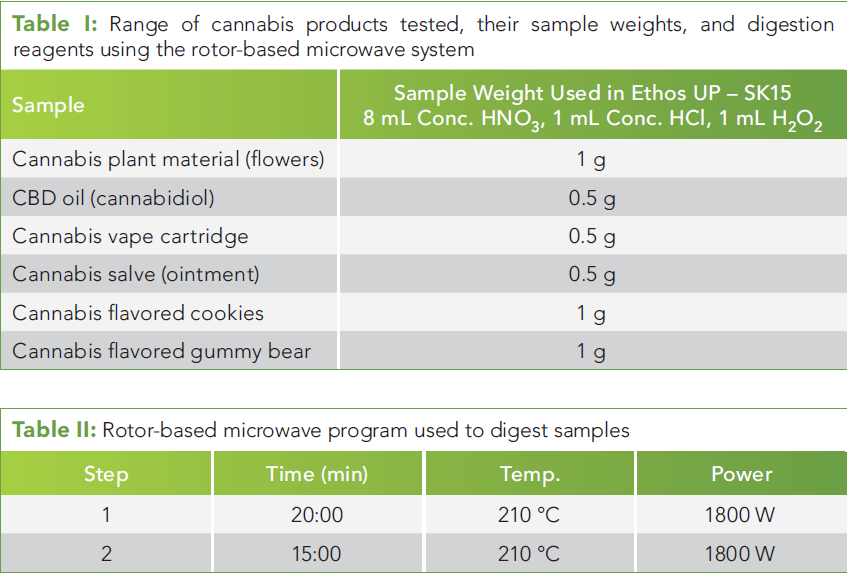
Results and Discussion
The performance of the rotor-based system was evaluated through a recovery study on samples of interest for the cannabis industry, from plant material to edibles and concentrates. All samples were fortified with a spike solution containing 20 ppb of all analytes, except for Hg, which was 10 ppb. The analytical results are shown in Table III with recoveries of all elements between 87–106% and relative standard deviations (RSDs) well below 3%.

Simultaneous Mixed-Batch Sample Preparation for Metals Testing of Cannabis Samples Using SRC Technology
The combination of SRC technology with ICP-MS allows cannabis analytical testing laboratories to analyze a broad variety of sample matrices with widely different sample weights and elemental requirements. SRC microwave digestion is a unique approach, incorporating all the benefits of closed-vessel microwave digestion while making sample preparation fast, easy, and extremely efficient. SRC technology operates at very high temperatures and pressures (up to 300 °C and 200 bar, respectively), allowing for complete digestion of even large sample sizes (up to 3–5 g) and difficult to digest matrices. Samples can be weighed directly into disposable glass vials, eliminating the need for acid cleaning and vessel assembly. Furthermore, SRC eliminates the need to batch samples because mixed sample types, weights, and acid chemistries can be successfully processed in the same run. This application describes how a variety of samples from the cannabis industry were digested simultaneously without sample-to-sample cross contamination.
Additionally, a soil sample was digested in the same analytical run as the cannabis products, to exemplify the capability of SRC technology to digest widely different matrices simultaneously in the same chamber. This approach would be very difficult to carry out with a rotor-based system, because of its batching limitations.
Analytical Procedure Using SRC Technology
Table IV shows the cannabis products tested, their sample weights and reagents used to digest them using SRC technology. Table V exemplifies the microwave program that was used to digest the samples. The resulting solutions produced were then made up to 50 mL with deionized water and presented to the ICP-MS instrument for analysis. Note: As with the previous method, only Pb, Cd, As, and Hg will be shown here, but 14 elements (As, Cd, Pb, Hg, Ag, Ba, Co, Cr, Cu, Mn, Ni, Se, V, and Zn) were evaluated. Please refer to the following reference for more information about the methodology used (6). It’s also important to point out that higher sample weights are typically used with SRC technology and there is no minimum sample volume that has to be used. In addition, because of the higher temperature and pressure capability of the SRC technology, digestion times are usually much shorter.
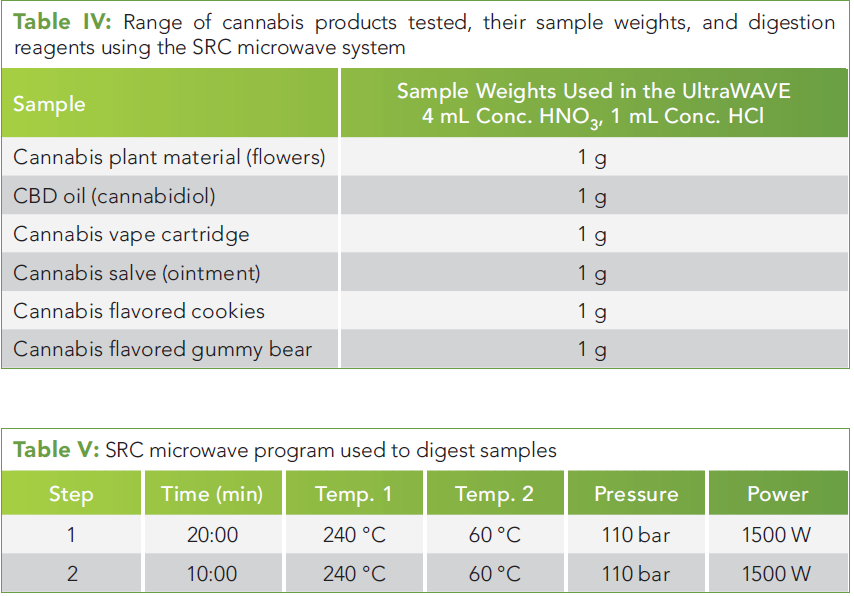
Results and Discussion
The performance of the SRC system was evaluated through a recovery study on samples of interest for the cannabis industry, from plant material to edibles and concentrates. All samples were fortified with a spike solution containing 20 ppb of all analytes, except for Hg, which was 10 ppb. A soil reference material (SRM 2711a) was also included in this study as a quality control sample and to show that a widely different matrix to cannabis products could be digested in the same sample run. It should be noted that the recoveries in the soil were calculated according to the total element content and represent the leachable fraction, based on the acid used. Refer to The National Institute of Standards and Technology (NIST) Certificate of Analysis for SRM 2711a for further details (7). The analytical results for the cannabis products and soil reference sample are shown in Table VI with recoveries of all analytes between 87.5–98.7% and RSDs well below 3%, clearly demonstrating the robustness and reproducibility of microwave digestion of different sample types using SRC technology. Note: The full data set for all 14 analytes can be viewed at the following reference (6).
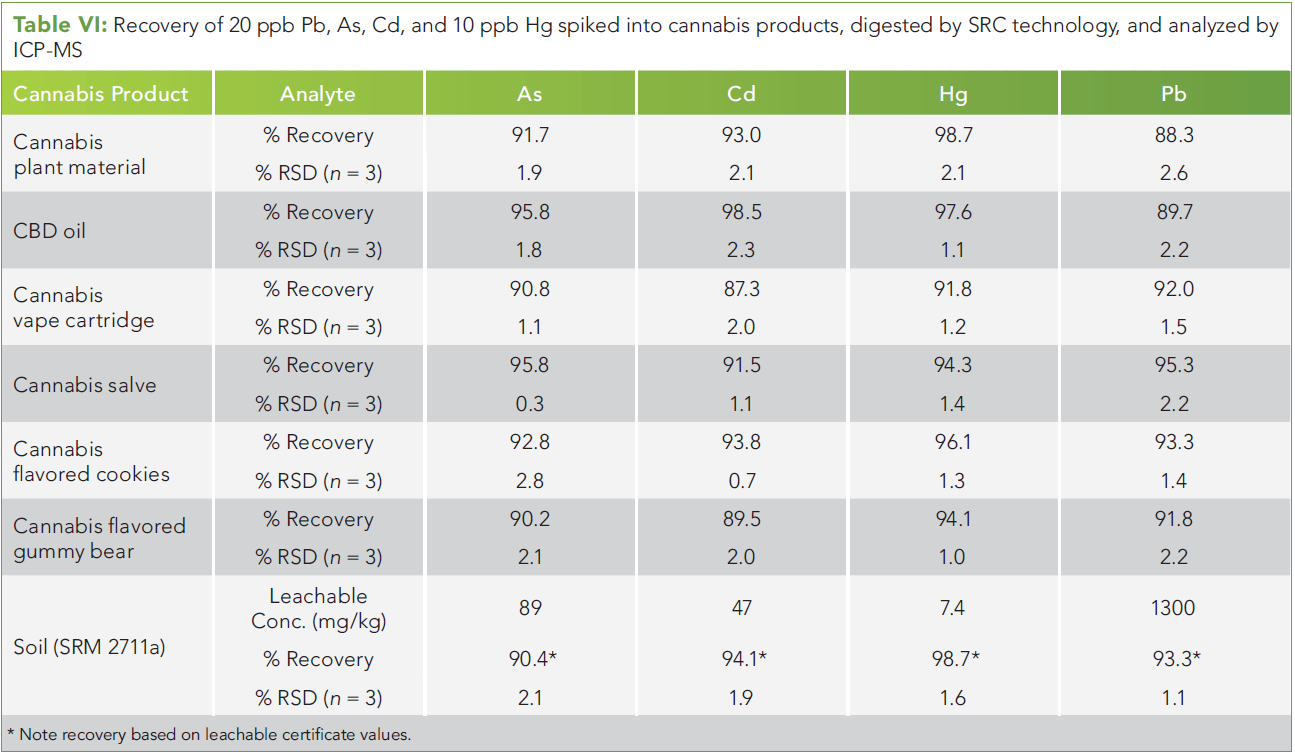
Final Thoughts
Modern plasma spectrochemical techniques will generate trace element data of the highest quality. However, with any solution technique, the data will only be as good as the sample presented to the instrument. For that reason, robust closed-vessel microwave digestion techniques are critically important to the overall analytical procedure.
The data in the first part of this study demonstrates full recovery of the most common elements found in cannabis plants and related products. Highly reactive samples such as gummy bears, cookies, and cannabidiol (CBD) oil have been completely digested even in large sample amounts, ensuring reliable analysis. In addition to good analyte spike recoveries, this approach, using a high-pressure, rotor-based system with a 15 position carousel also provides a high level of reproducibility, even for volatile elements such as As and Hg. And if higher sample throughput is required for less demanding matrices, it should be noted that a 44-position option is available.
However, for contract laboratories that might be handling a more diverse and complex range of samples such as supplements, pharmaceutical, or even soil samples, a rotor-based system might be somewhat restrictive, because similar samples have to be batched together to ensure they are being digested under the optimum conditions. Therefore, if there is a need to digest many differing sample matrices simultaneously in the same run, an SRC system could be the best solution. Because of its higher sample capacity, use of disposable vials, and faster cool down times, sample throughput processing with SRC technology is up to 2–3 times higher than conventional closed-vessel digestion systems. The ability to digest different sample types together and larger sample weights with minimal acid volume makes it the optimal technique to perform sample preparation for all cannabis related products, from the plant material to edibles, concentrates, and even to get a better understanding of the soil chemistry where the plants are growing.
There is no question that a new era of acceptance and legalization has opened new opportunities for cannabis testing laboratories, not only in heavy metals but also for an expanded list of analytes including potency, terpenoids, pesticides, residual solvents, moisture, mycotoxins, and pathogens. Standardization of these methods for the industry will give regulators the resources and information they need to include common sense regulations and legislation to monitor and control the use of cannabis within the United States’ medicinal and recreational markets. As a result, we are fully committed to supporting the cannabis testing industry for all their microwave digestion and extraction needs as exemplified by these two client testimonials (8,9).
References
1) “Growing Your Cannabis Testing Capabilities,” Milestone Inc. Product Note, https://milestonesci.com/cannabis-testing/.
2) “Microwave Digestion Vessel Venting Technology,” Milestone Inc., https://milestonesci.com/ethos-up-venting-technology/.
3) W. Lautenschlager, Milestone Srl, U.S. patent 5,270,010, 1990-06-13.
4) “Any Sample Any Time: The Benefits of Single Reaction Chamber Microwave Digestion for Trace Element Analysis: A White Paper,” Milestone Inc., https://milestonesci.com/webcasts/.
5) “Heavy Metals Determination in Cannabis Plant, Concentrates and Edibles Utilizing the Milestone Ethos UP,” Milestone in Technical Note, https://milestonesci.com/cannabis-testing/.
6) “Simultaneous Mixed-Batch Sample Preparation for Metals Testing of Medical Cannabis Samples Utilizing the Milestone UltraWAVE,” Milestone in Technical Note; https://milestonesci.com/cannabis-testing/.
7) The National Institute of Standards and Technology (NIST) Certificate of Analysis for SRM 2711a (Montana Soil): https://www-s.nist.gov/srmors/view_cert.cfm?srm=2711A.
8) “Milestone’s UltraWAVE allows Cannabis Lab to Streamline Heavy Metals Testing: CannaSafe Labs, Case Study,” https://milestonesci.com/cannabis-testing/.
9) “Milestone Technology Provides Cannabis Processor Quality and Efficiency in Terpene Extraction: Medezin Labs, Case Study,”https://milestonesci.com/cannabis-terpenes-extraction/.
Ryan Boyle and Eric Farrell are with Milestone Inc., in Shelton, Connecticut. Direct correspondence to: r.boyle@milestonesci.com and e.farrell@milestonesci.com
Visit the LabX Milestone Store
Learn more about Milestone’s rotor-based technology:
https://www.labx.com/item/
Learn more about Milestone’s single reaction chamber (SRC) technology:
https://www.labx.com/item/










